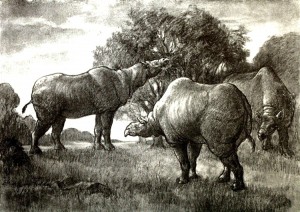Monster Monday: the Paraceratherium
December 5, 2016
Imagine going to the zoo and seeing a horselike rhinoceros the size of a small house. It may sound like a fairy tale monster, but Paraceratherium—break it down: para-cera-therium (par uh sehr uh THIHR ee uhm)—was real and it was the largest land mammal that has ever lived. Paraceratherium, which provided inspiration for the gargantuan AT-AT walkers seen in the Star Wars film and entertainment franchise, reached over 16 feet (5 meters) in height. Its skull alone was over 4 feet (1.2 meters) long.

Watch their step: a Paraceratherium herd feeds on a not-so-small leafy tree. Credit: American Museum of Natural History
A prehistoric relative of the modern rhinoceros, Paraceratherium roamed central Asia between 20 and 30 million years ago. It was about 10 feet (3 meters) taller than modern rhinos, and it had no horn. The giant walker had long legs and a long neck to reach leaves in the treetops. Paraceratherium ate vast amounts of plant matter every day to maintain its massive 15-ton (13.6-metric ton) weight. It was so big that even a newborn calf was too much for many large predators to handle, especially with its massive mother lurking protectively nearby. Males had very thick skulls, which they used on each other as clobbering weapons while competing for mating rights with females. The thunderous stomping and skull-crashing during these combats probably warned other creatures to stay far away.
Scientists suspect that Paraceratherium’s cumbersome size led to its demise. Such a gigantic body requires a lot of food fuel and can easily overheat, which is why most modern mammals tend to be small- to medium-sized. Droughts, food shortages, and heat waves would have left Paraceratherium quite vulnerable. Females gave birth to only one calf every few years, so it would have been difficult for these prehistoric giants to keep their population numbers up during tough times.


